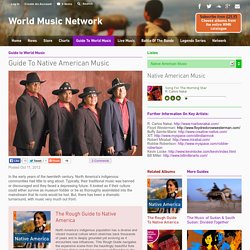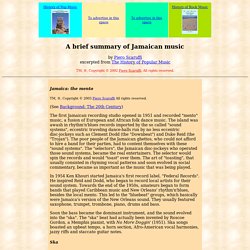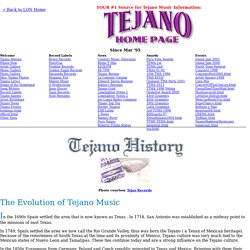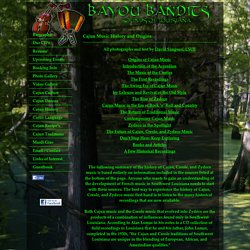

Native American Music. Guide To Native American Music – World Music Network – Guide To World Music. In the early years of the twentieth century, North America's indigenous communities had little to sing about.

Typically, their traditional music was banned or discouraged and they faced a depressing future. It looked as if their culture could either survive as museum fodder or be so thoroughly assimilated into the mainstream that its roots would be lost. But, there has been a dramatic turnaround, with music very much out front. The Rough Guide to Native America North America’s indigenous population has a diverse and vibrant musical culture which stretches back thousands of years and is deeply grounded yet evolving as it encounters new influences.
While non-Native consumers might equate Native America mainly with flute music and its New Age hybrids, for Native communities it is powwow music and regional styles like Arizona’s chicken scratch. Proceedings usually begin with a grand entry into the arena, led by flag bearers. Native American - War Song - Audio example. Native American POW WOW fast song- video example. Reggae Music. A History of Reggae Music. Jamaica: the mento TM, ®, Copyright © 2003 Piero Scaruffi All rights reserved.

(See Background: The 20th Century) The first Jamaican recording studio opened in 1951 and recorded "mento" music, a fusion of European and African folk dance music. The island was awash in rhythm'n'blues records imported by the so called "sound systems", eccentric traveling dance-halls run by no less eccentric disc-jockeys such as Clement Dodd (the "Downbeat") and Duke Reid (the "Trojan").
The poor people of the Jamaican ghettos, who could not afford to hire a band for their parties, had to content themselves with these "sound systems". In 1954 Ken Khouri started Jamaica's first record label, "Federal Records". Soon the bass became the dominant instrument, and the sound evolved into the "ska". Ska TM, ®, Copyright © 2003 Piero Scaruffi All rights reserved. (See The Age of Revivals) Pablo Moses — Reggae audio example. Buffalo Soldier - Bob Marley & The Wailersm- Reggae video example. Salsa music. Origins of Salsa ~ www.justsalsa.com ~ Echale Salsita. Celia Cruz – Pa' La Paloma - Salsa audio example.
Tito Puente – Salsa video example. Tex-Mex Music. Tejano Music History. Photo courtesy Tejas Records The Evolution of Tejano Music In the 1690s Spain settled the area that is now known as Texas .

In 1718, San Antonio was established as a midway point to the missions of east Texas. In 1749, Spain settled the area we now call the Rio Grande Valley, thus was born the Tejano ( a Texan of Mexican heritage). Because of the remoteness of South Texas at the time and its proximity of Mexico, Tejano culture was very much tied to the Mexican states of Nuevo Leon and Tamalipas. In the 1850s Europeans from Germany, Poland and Czech republic migrated to Texas and Mexico. It was a rough life, but one of pride. With the accordion, drum and the bajo sexto, a 12 string bass guitar from Spain, Tejanos now had a sound they could begin to call their own.
In the 1950s, Isidiro Lopez further revolutionize the Tejano sound by taking out theflowery Spanish that Valerio used and used Tex-Mex instead. Will Tejano change? Al Hurricane – Tex mex audio example. Selena- Como La Flor- Tex Mex video example. Cajun Music. History and Origins of Cajun Music - The Bayou Bandits ~ Sounds of Louisiana ~ The NorthEast's Premier Cajun-Zydecco Band. Dewey Balfa at left with Eli Stutes performing in the LSUE Acadian Center in 1979 a few months after the tragic death of Dewey's brothers, Rodney and Will, in a highway accident.

The Balfa Brothers have been described as the "quintessential Cajun band. " Vinesse LeJeune on fiddle and Alphonse "Bois Sec" Ardoin on accordion with Canray Fontenot behind them performing in the LSUE Acadian Center in 1979. Different versions of these musical subgenres like Cajun-country continue until this day, but one more development is of crucial importance in shaping Cajun music. In 1964, Gladius Thibodeaux, Louis "Vinesse" LeJeune, and Dewey Balfa (who joined as a last minute replacement playing guitar) accepted an invitation to represent Louisiana performing traditional Cajun music at the Newport Folk Festival. After their performance, they received a standing ovation. Balfa Brothers - Drunkards Waltz- Cajun audio example. Ho Bye Moreau By Morand Cajun band- Cajun video example. Hawaiian Slack Key Guitar Music. Sending Aloha From Maui, Hawai‘i. Hawaiian slack key guitar (ki ho'alu) is truly one of the great acoustic guitar traditions in the world.

Ki ho'alu, which literally means "loosen the key," is the Hawaiian language name for the solo fingerpicked style unique to Hawai'i. In this tradition, the strings (or "keys") are "slacked" to produce many different tunings, which usually contain a major chord, or a chord with a major 7th note, or sometimes one with a 6th note in it. Each tuning produces a lingering sound behind the melody and has a characteristic resonance and fingering.
Many Hawaiian songs and slack key guitar pieces reflect themes like stories of the past and present and people's lives. But it is the tropical surroundings of Hawai'i, with its oceans, volcanoes and mountains, waterfalls, forests, plants and animals, that provide the deepest source of inspiration for Hawaiian music. There is a mystique surrounding slack key guitar music - it is very personal, and can be very magical in feeling.
Cyril Pahinui – Slack Key Guitar Audio Example. Ledward Kaapana - "Opihi Moemoe"- Hawaiian Slack Key Video Example.